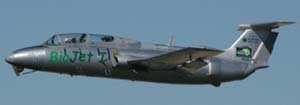Biodiesel as jetfuel

Green Flight Int’l last month completed what they claim was the first-ever jet flight using pure biodiesel:
RENO, NV. (October 5)… Aviation history was made earlier this week in the high desert at the Reno-Stead Airport when an L-29 military aircraft piloted by Carol Sugars and Douglas Rodante succeeded in completing the world’s first jet flight powered solely by 100% biodiesel fuel. The Czechoslovakian-made aircraft is rated to fly on a variety of fuels including heating oil, making it the preferred platform for testing biodiesel in jet engines.
Renewable jet fuel is also the focus of a collaboration announced by Boeing, Rolls Royce and Air New Zealand. I guess they’re beginning to smell the humus – with the fuel cost being a major component of airline operations cost, tapping into renewables is becoming a serious business proposition. And a marketing bonus.
The demonstration flight is planned for the second half of 2008 using an Air New Zealand Boeing 747-400 equipped with Rolls-Royce engines. Boeing is in discussions with fuel-source providers around the globe to identify potential biofuels that are available in suitable quantities for laboratory and jet-engine performance testing and in compliance with stringent aviation requirements.
Boeing, Air New Zealand and Rolls-Royce Announce Biofuel Flight Demo, The Green Car Congress, 28 September 2007
My understanding is that one of the challenges of using biodiesel as jet fuel is cold-flow at high altitudes. The fuel tanks are not heated, and so the fuel, when exposed to the low temperatures at high altitudes has to have decent cold-flow properties. That’s why kerosene is used in aviation and not cheaper diesel. Biodiesel has generally poor cold-flow properties – depending on the feedstock, it can gel as high as 40 Deg. F/ 5° C. Other than cold flow, Biodiesel, petro-diesel and kerosene/jet fuel are pretty much interchangeable. In addition to the better emissions and renewable qualities of biodiesel, there is also a safety dimension to using biodiesel. The higher flashpoint should reduce the risk of fire for emergency landings and crashes.